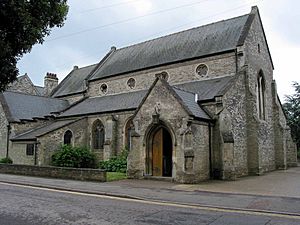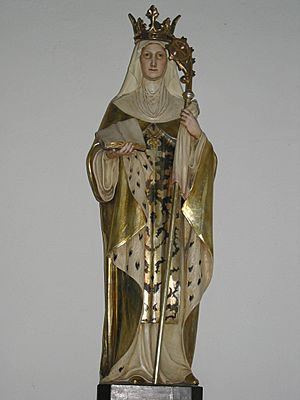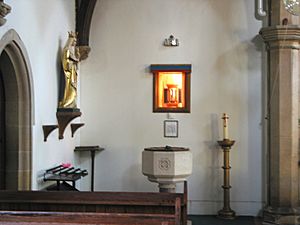St Etheldreda's Church, Ely facts for kids
Quick facts for kids St Etheldreda's |
|
|---|---|
| Shrine and Parish Church of St Etheldreda, Ely | |
 |
|
| 52°24′06″N 0°15′41″E / 52.401725°N 0.261408°E | |
| Location | 19 Egremont Street, Ely, Cambs, CB6 1AE |
| Country | England |
| Denomination | Roman Catholic |
| Website | https://elyrcchurch.com |
| History | |
| Relics held | St Etheldreda (First Class) |
| Architecture | |
| Style | Gothic Revival |
| Years built | 1903 |
| Administration | |
| Diocese | Diocese of East Anglia |
St Etheldreda's Church is a Roman Catholic church located in Ely, England. It is a special place because it holds the national shrine and relics of St Etheldreda. She was an Anglo-Saxon queen and abbess who lived a very long time ago, dying in AD 679. St Etheldreda became one of the most famous saints in England during the Middle Ages.
Contents
The Story of St Etheldreda's Church
By the mid-1800s, about 30-40 Catholic people lived in Ely. However, there was no priest living there. A priest from Cambridge, Canon Thomas Quinlivan, would sometimes visit. He traveled by train after the London to Norwich railway opened in 1845. He would hold church services in a private house.
The church community in Ely officially started in 1890. A priest named Fr John Francis Freeland came to Ely. He made a small chapel in his own room. In 1891, Ely had over 8,000 people, but only 16 Catholics attended church. As more people joined, Fr Freeland bought some land. In 1892, he opened a small chapel made of corrugated iron. This was on the same spot where the current church stands today.
The original iron chapel was later moved. It was used as a chapel in Thorney Toll until about 1973. After that, it was sold and became a garage.
When the first church opened in 1892, here were some of the services:
- Sunday mass at 8:30 a.m. and 11 a.m.
- Catechism (religious teaching) at 3 p.m.
- Rosary, instruction, and benediction at 6:30 p.m.
- Daily mass at 8 a.m.
The church community slowly grew. By the early 1930s, there were about 100 members. During and after the Second World War, many Italian and German Prisoners of War were in the Fens area. Some of them were in a camp near Ely and attended St Etheldreda's Church.
What the Church Looks Like
The church building you see today opened on October 17, 1903. This date is special because it's the feast day when St Etheldreda's relics were moved. The church was not officially blessed until May 22, 1987. This was because of money issues when it first opened.
The church was designed by Simon Croot. It was built by Messrs Howard. The cost to build the church was £2,600. The house for the priest cost another £900.
The church was named after St Etheldreda because she died in Ely.
The building is in a style called Decorated Gothic. It has a raised area for the altar and two side sections. Inside, you can see many beautiful stained glass windows. These windows show different saints and scenes, including:
- St Peter
- St Pius X
- St Margaret Clitheroe
- St John Houghton
- St Francis
- St John the Evangelist
- The Good Shepherd
- Jesus as Priest
The main window behind the altar is very special. It shows St Wilfrid, Our Lady, and St Etheldreda. This window is a copy of a similar one found in York Minster.
Priests of St Etheldreda's
Many priests have served at St Etheldreda's Church over the years.
| Parish Priest | Years at St Etheldreda's |
|---|---|
| Rev. John Francis Freeland | 1890–1906 |
| Rev. David Finegan | 2019- |
The Shrine of St Etheldreda
The main shrine of St Etheldreda today is inside St Etheldreda's Church in Ely. In the Middle Ages, her main shrine was at the Abbey of Ely. St Etheldreda was one of the most popular Anglo-Saxon saints. Her shrine was one of the five most visited places for pilgrims in medieval England. People traveled from far away to visit it until the 1520s.
A big reason for St Etheldreda's fame was that her body was found to be whole and lifelike after she died. It did not decompose like normal bodies. This was written down by a historian named Bede very early on. This helped her story and fame spread widely.
During the Middle Ages, many churches claimed to have small parts of St Etheldreda's body, called relics. These included churches in Durham, Glastonbury, and York. We don't know for sure if these were real relics. However, a discovery in the 1800s suggests that parts of her body might have been shared.
People also used to collect lace necklaces and other items linked to St Etheldreda. These were believed to help with things like sore throats, headaches, and childbirth.
During the English Reformation in the 1500s, St Etheldreda's shrine was destroyed. Her worship stopped. Some pieces of the old shrine are thought to have survived in Ely. For example, painted panels showing scenes from her life were found being used as a cupboard door in the 1780s. A small carved stone from the 700s, found in a barn, is also thought to be from the shrine.
The exact date the medieval shrine was destroyed is not known. It likely happened after October 21, 1541. On this date, the bishop of Ely ordered that "all images, relics, table monuments of miracles and shrines" should be taken down. Records show that a lot of gold and silver was taken from the shrine and given to the king.
A modern relic of St Etheldreda is her left hand. It was found hidden in a house in Sussex around 1811. It was given to the Duke of Norfolk and later to a group of nuns called the Dominican Sisters. The hand was found with a silver plate that said 'Manus Sanctae Etheldredae DCLXXIII' (Hand of St Etheldreda 673). This plate was from the 900s, suggesting the hand was separated from her body around that time. In 1876, it was reported that the hand was "perfectly entire and quite white" when found. But over time, it turned dark brown and cracked.
A small piece of St Etheldreda's hand was given back to the Ely church in 1950. It came from St Etheldreda's Church in London. The main part of the hand stayed with the Dominican sisters. They donated it to the Ely church in June 1953. It has been there ever since.
The shrine today is quite simple. It shows St Etheldreda's hand in a glass case. Until the late 1960s, there was a small altar dedicated to St Etheldreda. But after some church changes, this altar was removed. In 1975, the church's font (where baptisms happen) was moved to this spot.
People still visit St Etheldreda's shrine today. They often visit the small Roman Catholic church and also Ely Cathedral. The Cathedral is where the medieval shrine used to be before it was destroyed.



